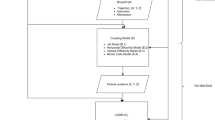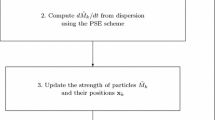Abstract
A major assumption of the Empirical Transport Model (ETM), widely adopted by both electric utilities and regulatory agencies for estimating the effects of entrainment mortality on fish populations in estuaries, is that the fraction of ichthyoplankton entrained varies only in response to changes in water withdrawals, not to changes in freshwater flow. We evaluated this assumption using a particle-tracking model to estimmate the probability of entrainment at power plants on the Hudson River during low and high freshwater flow periods and comparing those probabilities with estimates calculated from the ETM. We found that freshwater flow had a profound effect on the probability of entrainment. Both the number of river regions from which particles were entrained and the probabilities of entrainment for particles in those river regions differed between low-flow and high-flow periods. During high flow, particles spent less time in the grid box next to the intakes, reducing the probability of entrainment for particles released in the river region of each power plant and the average probability of entrainment across all regions at three power plants. The reduced probability of entrainment for particles released in the river regions of two power plants was offset by higher entrainment for particles upriver of these power plants. Although the average probabilities of entrainment across all river regions estimated with the particle-tracking model and the ETM were relatively similar for some power plants at high flow, low flow, or both, the probabilities for each river region differed considerably between the models. The number of river regions from which particles were entrained using the ETM was consistently undersestimated, resulting in probabilities for regions where entrainment occurred that were biased high compared with the particle-tracking model.
Similar content being viewed by others
Literature Cited
Bigelow, H. B. andW. C. Schroeder. 2002. Fishes of the Gulf of Maine, 3rd edition, Smithsonian Institution Press, Washington, D.C.
Blumberg, A. F., Z. G. Jt, andC. K. Ziegler., 1996. Modeling outfall plume behavior using far field circulation model.Journal of Hydraulic Engineering 122:610–616.
Blumberg, A. F., L. A. Khan, andJ. P. St. John. 1999. Threedimensional hydrodynamic model of New York Harbor region.Journal of Hydraulic Engineering 125:799–816.
Blumberg, A. F. andB. N. Kim. 2000. Flow balances in St. Andrew Bay revealed through hydrodynamic simulations.Estuaries 23:21–33.
Blumberg, A. F. andG. L. Mellor. 1987. A description of a three dimensional coastal ocean circulation model, p. 1–16.In N. Heaps (ed.), Three Dimensional Coastal Ocean Models, Volume 4. American Geophysical Union, Washington, D.C.
Boreman, J. andC. P. Goodeyear. 1988. Estimates of entrainment mortality for striped bass and other fish species inhabiting the Hudson River estuary.American Fisheries Society Monography 4:152–160.
Brickman, D. andP. C. Smith. 2002. Lagrangian stochastic modeling in coastal oceanography.Journal of Atmospheric and Oceenic Technology 19:83–99.
Brown, C. A., G. A. Jackson, andD. A. Brooks. 2000. Particle transport through a narrow tidal inlet due to tidal forcing and implications for larval transport.Journal of Geophysical Research 105:24141–24156.
Coffey, W. T., Y. P. Kalmykov, andJ. T. Waldron. 2003. The Langevin Equation: With Applications to Stochastic Problems in Physics, Chemistry and Electrical Engineering, 2nd edition. World Scientific Publishing Co., Inc., River Edge, New Jersey.
Constantinescu, G. S. andV. C. Patel. 1998. Numerical model for simulation of pump-intake flow and vortices.Journal of Hydraulic Engineering 124:123–134.
Cooper, J. C., F. R. Cantelmo, andC. E. Newton. 1988. Overview of the Hudson River estuary.American Fisheries Society Monograph 4:11–24.
Dimou, K. N. andE. E. Adams. 1993. A random-walk, particle tracking model for well-mixed estuaries and coastal waters.Estuarine, Coastal and Shelf Science 37:99–110.
Dragos, P. andW. R. Geyer. 1998a. Entrainment of passive particles into Hudson River power plants: Data report for the low-discharge condition survey. Coastal Oceanographic Associates, Sandwich, Massachusetts.
Dragos, P. andW. R. Geyer. 1998b. Entrainment of passive particles into Hudson River power plants: Data report for the high-discharge condition survey. Coastal Oceanographic Associates, Sandwich, Massachusetts.
Dunning, D. J., Q. E. Ross, andM. W. Merkhofer. 2000. Multiattribute utility analysis for addressing Section 316(b) of the Clean Water Act.Environmental Science and Policy 3:S7-S14.
Electric Power, Research Institute. 1999. Catalog of Assessment Methods for Evaluating the Effects of Power Plant Operations on Aquatic Communities Electric Power Research Institute, Palo Alto, California.
Electric Power Research Institute. 2000. Review of Entrainment Survival Studies: 1970–2000. Electric Power Research Institute, Palo Alto, California.
Fortier, L. andW. C. Leggett. 1983. Vertical migrations and transport of larval, fish in a partially mixed estuary.Canadian Journal of Fisheries and Aquatic Sciences 40:1543–1555.
Garvine, R. W., C. E. Epifanio, C. C. Epifanio, andK.-C. Wong. 1997. Transport and recruitment of blue crab larvae: A model with advection and mortality.Estuarine, Coastal and Shelf Science 45:99–111.
Geyer, W. R. andR. P. Signell. 1992. A reassessment of the role of tidal dispersion in estuaries and bays.Estuaries 15:97–108.
Hutchison, Jr.,J. B. 1988. Technical descriptions of Hudson River electricity generating stations.American Fisheries Society Monograph 4:113–120.
Lott, N., T. Ross, andA. Graumann. 2001. NCDC products and services guide. National Climatic Data Center, Asheville, North Carolina.
Mellor, G. andT. Yamada. 1982. Development of a turbulence closure model for geophysical fluid problems.Reviews of Geophysics and Space Physics 20:851–875.
Mellor, G. L. 2001. One-dimensional ocean surface layer modeling: A problem and a solution.Journal of Physical Oceanography 31:790–809
Melville, B. W., R. Ettema, andT. Nakato. 1994. Review of flow problems at water intake pump sumps. EPRI Research Project RP3456-01, final report. Iowa Institute of Hydraulic Research, The University of Iowa, Iowa City, Iowa.
Smagorinsky, J. 1963. General circulation experiments with the primitive equations. I. The basic experiment.Monthly Weather Review 91:99–164.
Solomon, T. H., E. R. Weeks, andH. L. Swinney. 1994. Chaotic advection in a two-dimension flow: Levy flights and anomalous diffusion.Physica D: Nonlinear Phenomena 76:70–84.
Thomson, D. J. 1987. Criteria for the selection of stochastic models of particle trajectories in turbulent flows.Journal of Fluid Mechanics 180:529–556.
Tompson, A. F. B. andL. W. Gelhar. 1990. Numerical simulation of solute transport in three-dimensional randomly heterogenoous porous media.Water Resources Research 26:2541–2562.
U.S. Environmental Protection Agency (U.S. EPA). 2002. National pollutant discharge elimination system—Proposed regulations to establish requirements for cooling water intake structures at Phase II existing facilities, proposed rule.Federal Register 67:17122–17225.
U.S. Geologic Survey (USGS). 1998. Water Resources Data for New York, Water Years 1997, 1998. Water Resources Division, U. S. Geological Survey, Troy, New York.
Zhang, X. Y. 1995. Ocean outfall modeling—Interfacing near and far field models with particle tracking method. Ph.D. Dissertation, MIT, Cambridge, Massachusetts.
Source of Unpublished Materials
Central Hudson Gas and Electric Corporation, Consolidated Edison Company of New York, Inc., New York Power Authority, and Southern Energy New York. Unpublished data. 1999 draft environmental impact statement for state polutant discharge elimination system permits for Bowline Point 1 and 2, Indian Point 2 and 3, Roseton 1 and 2 steam electric generating stations. New York State Department of Environmental Conservation, Albany, New York.
Author information
Authors and Affiliations
Corresponding author
Rights and permissions
About this article
Cite this article
Blumberg, A.F., Dunning, D.J., Li, H. et al. Use of a particle-tracking model for predicting entrainment at power plants on the Hudson River. Estuaries 27, 515–526 (2004). https://doi.org/10.1007/BF02803543
Received:
Revised:
Accepted:
Issue Date:
DOI: https://doi.org/10.1007/BF02803543




